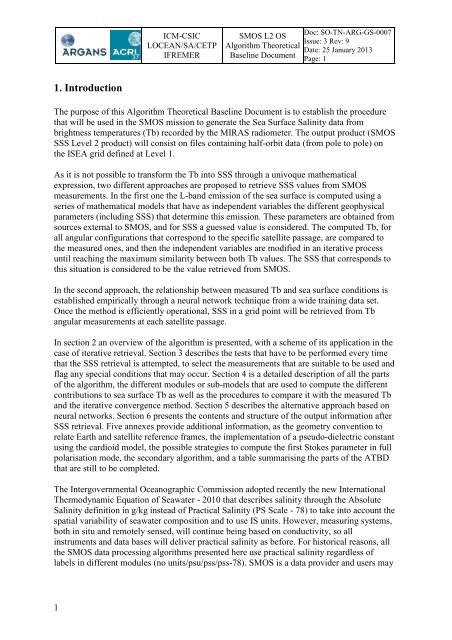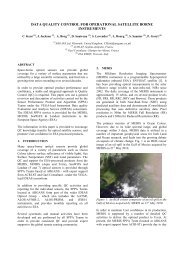SMOS L2 OS ATBD - ARGANS
SMOS L2 OS ATBD - ARGANS
SMOS L2 OS ATBD - ARGANS
You also want an ePaper? Increase the reach of your titles
YUMPU automatically turns print PDFs into web optimized ePapers that Google loves.
1. Introduction<br />
1<br />
ICM-CSIC<br />
LOCEAN/SA/CETP<br />
IFREMER<br />
<strong>SM<strong>OS</strong></strong> <strong>L2</strong> <strong>OS</strong><br />
Algorithm Theoretical<br />
Baseline Document<br />
Doc: SO-TN-ARG-GS-0007<br />
Issue: 3 Rev: 9<br />
Date: 25 January 2013<br />
Page: 1<br />
The purpose of this Algorithm Theoretical Baseline Document is to establish the procedure<br />
that will be used in the <strong>SM<strong>OS</strong></strong> mission to generate the Sea Surface Salinity data from<br />
brightness temperatures (Tb) recorded by the MIRAS radiometer. The output product (<strong>SM<strong>OS</strong></strong><br />
SSS Level 2 product) will consist on files containing half-orbit data (from pole to pole) on<br />
the ISEA grid defined at Level 1.<br />
As it is not possible to transform the Tb into SSS through a univoque mathematical<br />
expression, two different approaches are proposed to retrieve SSS values from <strong>SM<strong>OS</strong></strong><br />
measurements. In the first one the L-band emission of the sea surface is computed using a<br />
series of mathematical models that have as independent variables the different geophysical<br />
parameters (including SSS) that determine this emission. These parameters are obtained from<br />
sources external to <strong>SM<strong>OS</strong></strong>, and for SSS a guessed value is considered. The computed Tb, for<br />
all angular configurations that correspond to the specific satellite passage, are compared to<br />
the measured ones, and then the independent variables are modified in an iterative process<br />
until reaching the maximum similarity between both Tb values. The SSS that corresponds to<br />
this situation is considered to be the value retrieved from <strong>SM<strong>OS</strong></strong>.<br />
In the second approach, the relationship between measured Tb and sea surface conditions is<br />
established empirically through a neural network technique from a wide training data set.<br />
Once the method is efficiently operational, SSS in a grid point will be retrieved from Tb<br />
angular measurements at each satellite passage.<br />
In section 2 an overview of the algorithm is presented, with a scheme of its application in the<br />
case of iterative retrieval. Section 3 describes the tests that have to be performed every time<br />
that the SSS retrieval is attempted, to select the measurements that are suitable to be used and<br />
flag any special conditions that may occur. Section 4 is a detailed description of all the parts<br />
of the algorithm, the different modules or sub-models that are used to compute the different<br />
contributions to sea surface Tb as well as the procedures to compare it with the measured Tb<br />
and the iterative convergence method. Section 5 describes the alternative approach based on<br />
neural networks. Section 6 presents the contents and structure of the output information after<br />
SSS retrieval. Five annexes provide additional information, as the geometry convention to<br />
relate Earth and satellite reference frames, the implementation of a pseudo-dielectric constant<br />
using the cardioid model, the possible strategies to compute the first Stokes parameter in full<br />
polarisation mode, the secondary algorithm, and a table summarising the parts of the <strong>ATBD</strong><br />
that are still to be completed.<br />
The Intergovernmental Oceanographic Commission adopted recently the new International<br />
Thermodynamic Equation of Seawater - 2010 that describes salinity through the Absolute<br />
Salinity definition in g/kg instead of Practical Salinity (PS Scale - 78) to take into account the<br />
spatial variability of seawater composition and to use IS units. However, measuring systems,<br />
both in situ and remotely sensed, will continue being based on conductivity, so all<br />
instruments and data bases will deliver practical salinity as before. For historical reasons, all<br />
the <strong>SM<strong>OS</strong></strong> data processing algorithms presented here use practical salinity regardless of<br />
labels in different modules (no units/psu/pss/pss-78). <strong>SM<strong>OS</strong></strong> is a data provider and users may



